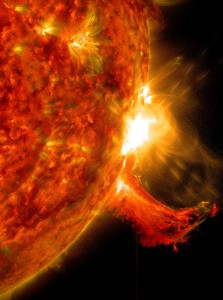December 1, 2015
National Space Weather Strategy and Action Plan
Posted by bwebster
This blog post was written by Delores Knipp, Editor in Chief of AGU’s Space Weather Journal.
When one thinks of the kinds of weather that might grab headlines or be worthy of policy considerations, terms like polar vortices, fire weather, super-typhoons and El Nino come to mind. “Space Weather,” which refers to variations in the space environment between the sun and Earth (and throughout the solar system) that can affect technologies in space and on Earth, is rarely at the top of the public watch list. In fact most people don’t know that there is such a thing, which is exactly the reason the White House Office of Science Technology Policy (OSTP) recently spearheaded an effort to bring space weather concerns to the forefront with a newly developed National Space Weather Strategy and Action Plan. These documents were released to the public in late October 2015 after a multi-year coordinated interagency effort to improve the Nation’s ability to prepare, avoid, mitigate, respond to, and recover from the potentially devastating impacts of space-weather events.

Unlike terrestrial weather with its rain, snow, and tree-bending wind, space weather is mostly invisible. It plays out in the realm of individual charged particles in the radiation belts, sheets of tenuous currents in Earth’s magnetic domain and upheavals of Earth’s heated atmosphere in the near vacuum of space. (For the inquiring mind the Strategy Appendix provides a one-page tour of space weather drivers and effects.) In the past only an outbreak of the Northern or Southern lights (aurora) alerted the public to possibility of weather in the beyond. Solar imaging satellites and sensors well outside of Earth’s atmosphere can provide imagery and some lead-time for alerts and warnings of approaching disturbances. However, those who manage technology systems need to be aware of risks and have protective plans in place.
As noted in the Strategy Executive Summary: “Space weather can disrupt the technology that forms the backbone of this country’s economic vitality and national security, including satellite and airline operations, communications networks, navigation systems, and the electric power grid.” Increasing dependence on these means that space weather poses a growing risk to infrastructure and the economy. A host of previous studies have informed the Strategy and Action Plan. These can be found in the Strategy and Action Plan reference lists and in Knipp et al. [2015]
The combined efforts of the Department of Commerce, National Oceanic and Atmospheric Administration, the Department of Homeland Security and OSTP established six strategic goals:
- Establish Benchmarks for Space-Weather Events
- Enhance Response and Recovery Capabilities
- Improve Protection and Mitigation Efforts
- Improve Assessment, Modeling, and Prediction of Impacts on Critical Infrastructure
- Improve Space-Weather Services through Advancing Understanding and Forecasting
- Increase International Cooperation
Each with a series of associated objectives. These objectives receive further attention in the National Space Weather Action Plan.
Strategy implemen tation requires action from governments and agencies, national, state and local emergency managers, academia, the media, the insurance industry, nonprofit organizations, and the private sector. Enhanced observing networks and research are needed to improve prediction models, and supply the services necessary to protect life and property and to promote economic prosperity.
tation requires action from governments and agencies, national, state and local emergency managers, academia, the media, the insurance industry, nonprofit organizations, and the private sector. Enhanced observing networks and research are needed to improve prediction models, and supply the services necessary to protect life and property and to promote economic prosperity.
Aligned with investments proposed in the President’s Budget for Fiscal Year 2016, the Action Plan details the activities, outcomes, and timelines to be undertaken by Federal departments and agencies for the Nation to make progress toward the Strategy’s goals. The Action Plan is not a budget document. Commitment of federal and state resources is to be determined through the budget process. A reevaluation and update of the Strategy and Action Plan is recommended within 3 years, or as needed.
Previous strategy and action plans have addressed other critical policy concerns. The National Space Weather Strategy and Action Plan are the first guiding documents for response to severe space weather events at the federal and state levels. The documents represent a whole-of-government approach to guiding existing policy efforts to “drive the activities necessary to improve the security and resilience of critical technologies and infrastructures” during and after extreme events that arise from solar storms.
To read more about the impacts of space weather check out AGU’s Space Weather Quaterly
Knipp, D. J. (2015), Forward to space weather collection on geomagnetically induced currents: Commentary and research, Space Weather, 13, doi:10.1002/2015SW001318.



[…] This blog post was written by Delores Knipp, Editor in Chief of AGU’s Space Weather and Space Weather Quaterly. To learn more about space weather, read Dr. Knipp’s previous post on the National Space Weather Strategy and Action Plan. […]